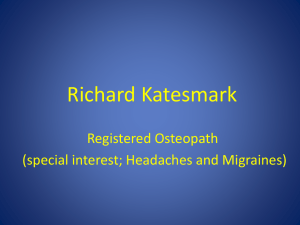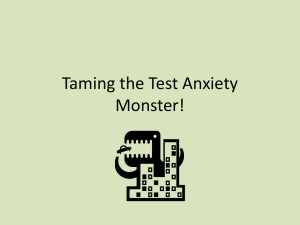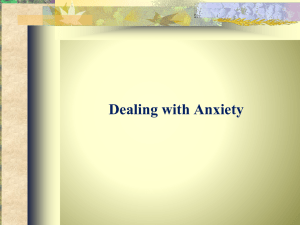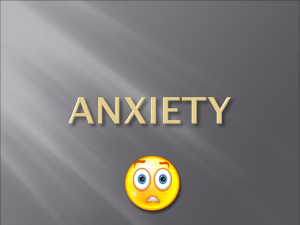1-anxiety disorders DSM 5
advertisement
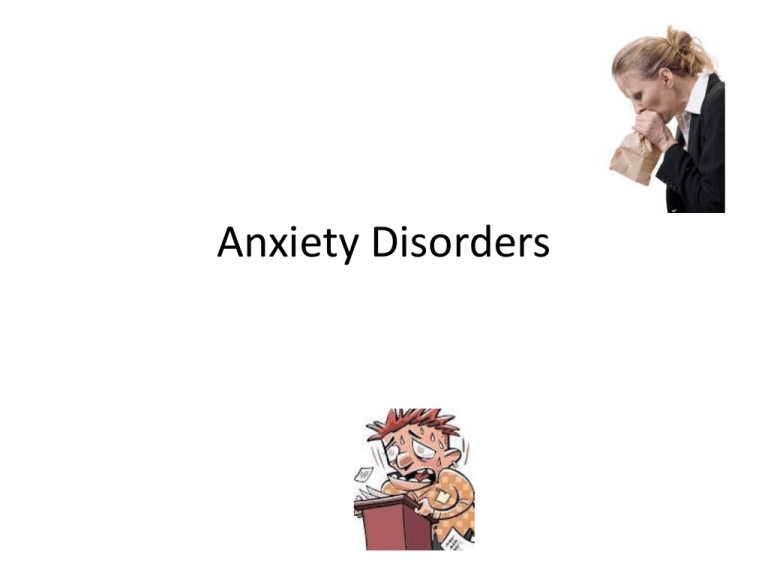
Anxiety Disorders Anxiety Disorders • • • • • • • Separation anxiety disorder Selective Mutism Specific phobias Social anxiety disorder (social phobia) Panic disorder Agoraphobia Generalized anxiety disorder Specific Phobias diagnostic criteria • A. Marked fear or anxiety about a specific object or situation – Animals: cats, spiders – Natural Environmental: heights, storms – Blood- injection- injury: needles, invasive medical procedures – Situational: airplanes, elevators • B. The phobic object or situation almost always provokes immediate fear or anxiety Specific Phobias: diagnostic criteria • C. The phobic object or situation is actively avoided or endured with intense fear or anxiety • D. The fear or anxiety is out of proportion to the actual danger posed by the specific object or situation and to the sociocultural context • E. The fear anxiety or avoidance is persistent, typically lasting for 6 months Specific Phobias: diagnostic criteria • F. The fear, anxiety or avoidance causes clinically significant distress or impairment in social, occupational, or other important areas of functioning • G. Exclude any other mental disorders – Such as fear, anxiety and avoidance of situations associated with panic-like symptoms – Agoraphobia – Object or situation related to obsessions (OCD) – Reminder of traumatic event (PTSD) – Social situation (social phobia) Specific Phobias: diagnostic criteria • Associated features: – Individuals with situational, environmental or animal phobias show sympathetic nervous system arousal – Individuals with blood-injection-injury phobia demonstrate a vasovagal fainting and elevation of blood pressure followed by a deceleration of heart rate and a drop in blood pressure • Prevalence: – Women more than men 2:1 • Suicide risk is 60% more than normal people Specific Phobias: diagnostic criteria • Developmental course: – Sometimes develops after a traumatic event (e.g..; being attacked by an animal) or through observing others going in a traumatic event (watching some burning) – Develops early childhood between ages 7-11 years Social anxiety disorder (social phobia) diagnostic criteria • A. Marked fear or anxiety about one or more social situations in which the person exposed to possible scrutiny by others. – Social interaction: meeting new people – Being observed: eating or drinking – Performing in front of others: giving speech • B. The person feels that he/she will act in a way or show anxiety symptoms that will be negatively evaluated (that will be humiliating or embarrassing; will lead to rejection or offend others) Social anxiety disorder (social phobia): diagnostic criteria • C. The social situations almost always provoke anxiety or fear • D. the social situations are avoided or endured with intense anxiety or fear • E. The fear or anxiety is out of proportion to the actual threat posed by the social situation and to the socio-cultural context • F. The fear anxiety or avoidance is persistent, typically lasting for 6 months Social anxiety disorder (social phobia): diagnostic criteria • G. The fear or anxiety or avoidance causes clinically significant distress or impairment in social, occupational or other important areas of functioning • H. The fear or anxiety or avoidance is not attributed to the physiological affects of substance or another medical condition Social anxiety disorder (social phobia): diagnostic criteria • I. The fear or anxiety or avoidance is not explained by other mental disorders • J. If another medical condition (parkinson’s disease, disfigurement from burn, or injury) is present, The fear or anxiety or avoidance is clearly unrelated or is excessive Social anxiety disorder (social phobia): diagnostic criteria • Associated features: – Person may be inadequately assertive or excessively submissive – Show rigid body posture or inadequate eye contact or speak with low voice – May be shy and withdrawn and less open in conversations – Employed in jobs that does not need high contact with people – Drinking for becoming sociable is common Social anxiety disorder (social phobia): diagnostic criteria • Prevalence: – Women more than men – Gender differences occur more in adolescent • Developmental course: – Occurs early childhood – History of social inhibition – In adult rare but occurs after a painful or humiliating situation • Functional consequences – Drop out from school – Unemployment – Affects productivity in work Panic attacks 17 Panic Disorder diagnostic criteria • A. recurrent unexpected panic attacks. A panic is an abrupt surge of intense fear or discomfort that reaches a peak within minutes (the whole attack 5-10 minutes) Panic Anxiety Disorder A discrete period of intense fear or discomfort in which at least 4 of the following symptoms develop abruptly and reached a peak within few minutes • Palpitation, pounding heart, accelerated heart beats • Sweating • Trembling or shaking • Sensations of shortness of breath • Chills or heat sensations • Fear of dying • Feeling dizzy, unsteady, lightheaded, or faint • Feeling of choking • Chest pain • Nausea or abdominal distress • Numbness • Derealization • Fear of losing control 19 Panic Anxiety Disorder • B. At least one of the attacks has been followed by one month (or more) of one or both of the following: – Persistent concern about having additional panic attack or their consequences (losing control or having a heart attack) – A significant maladaptive change in behavior related to the attacks (avoiding unfamiliar situations, or exercise…) Panic Anxiety Disorder • C. The disturbance is not caused by physiological effects of substances, medications, or medical condition • D. the disturbance is not explained by another mental disorder Agoraphobia diagnostic criteria • A. Marked fear or anxiety about 2 or more of the following – 1. Using public transportation: buses, trains – 2. Being in open spaces: parking lots, bridges – 3. Being in enclosed places: shops, cinemas – 4. Standing in line or being in a crowed – 5. Being outside of the home alone Agoraphobia • B. The person fears or avoids these situations because of thoughts that escape might be difficult or help might not be available in the event of developing panic-like symptoms or other incapacitating or embarrassing symptoms (fear of incontinence) • C. The agoraphobia situation almost always provoke fear or anxiety Agoraphobia • D. the agoraphobia situations are actively avoided, require the presence of a companion, or endured with intense fear or anxiety • E. The fear or anxiety is out of proportion to the actual threat posed by the social situation and to the socio-cultural context • F. The fear or anxiety or avoidance is persistent typically for 6 months or more Agoraphobia • G. The fear or anxiety or avoidance causes clinically significant distress or impairment in social, occupational or other important areas of functioning • H. if another medical condition (eg.; inflammatory bowel disease, parkinson’s disease) is present the fear, anxiety or avoidance is clearly excessive • The fear, anxiety or avoidance is not explained by the symptoms of another mental disorder Generalized Anxiety Disorder Generalized Anxiety Disorder diagnostic criteria • A. Excessive anxiety and worry (apprehensive expectation), occurring more days than not, for at least 6 months, related to several events or activities (such as work or school performance) • B. The person finds it difficult to control the worry Generalized Anxiety Disorder • C. The anxiety and worry are associated with 3 or more of the following 6 symptoms (with at least some symptoms having been present for more days than not for the last 6 months) – 1. Restlessness or feeling keyed up or on edge – 2. Being easily fatigued – 3. Difficulty concentrating or mind going blank – 4. Irritability – 5. Muscle tension – 6. Sleep disturbance (difficulty falling or staying asleep or restless unsatisfying sleep) Generalized Anxiety Disorder • D. The anxiety, worry or physical symptoms cause significant distress or impairement in social, occupational or other important areas of functioning • E. The disturbance is not attributed to the physiological effects of substances, medications or medical condition • F. The disturbance is not explained by other mental disorders Nursing Care of Clients with Anxiety Disorders Social Phobia • Alia a 19 year old college student, complains of extreme anxiety about her classes. She said “I am doing very well with my written assignments and exams but I am worried that I am going to fail two of my courses because each requires participation in the discussion of topics in the class and an oral presentation in front of all the students”. She states that she will not be able to do this because “every one will think I am stupid”, although she recognizes that “It does not make any sense, I just started the college last semester, I was not like this in the high school”. A case of simple phobia: Fear from riding elevators • MS. A 32 year old woman seeks help because she fears losing her job • She work for a large company and was recently promoted to a new job on the 20th floor of the building. She reports a long inability to ride on elevators due to overwhelming fear accompanied with palpitations, diaphoresis and dyspnea. • She has always taken the stairs to her office, but now this has made her late for meetings. She realizes her fears are irrational but has been unable to change her behavior. She reports normal sleep, appetite, and energy level. There is no past history of traumatic events or OCD. • Physical and neurological exams normal. • Normal Lab tests & MRI Nursing diagnosis: Fear • On assessment MS A. she says “I am afraid to get in the elevator. I fear if it stops no one will come to rescue or it will fall down. (related to) When ever I think of riding it, I become anxious, my heart pounds highly and I become sweaty all over my body and I feels as if I am going to suffocate. So I decide it is safer to climb the stairs even if I am late. I know this is not rational but I can not stop it (evidence)” Goals of Nursing Interventions Long Term Goal: ◦ MS. A. will be able to ride the elevator to her office without experiencing a panic attack Short term Goal: MS A. will ◦ Verbalize feelings of fear and discomfort ◦ Respond to relaxation techniques with decreased anxiety ◦ Effectively decrease own anxiety level ◦ Decrease avoidance behaviors ◦ Manage the anxiety response effectively • Develop trust relationship and interact with the client on one-to-one session, in-order to help MS. A talk about her feelings of fear and discomfort – Reassure MS. A. that she will not be forced to confront the phobic situation (riding the elevator) until she is prepared and ready to do so – Assist the client to distinguish between the phobic trigger and thoughts (elevator will fall) and her physiological responses and the avoidance behaviors that are interfering with daily life I fear if it stops no one will come So I decide it is safer to to rescue or it will fall down. climb the stairs even if I Thoughts am late. I know this is not rational but I can not Physical Behavior stop it my heart Feelings I am afraid to get in the elevator. I decide it is safer to climb the stairs even if I am late pounds highly and I become sweaty all over my body and I feels as if I am going to suffocate. Respond to relaxation techniques with decreased anxiety • Instruct MS. A. in progressive relaxation techniques. These include deep breathing, focusing on specific muscles to decrease tenseness, and imagining. • Encourage the client to practice relaxation until he or she is comfortable and successful. • Explain systematic desensitization thoroughly to the client (see next slide). • Reassure the client that you will allow him or her as much time as needed at each step. • Effectively decrease own anxiety level desensitization Have the client develop a hierarchy of situations that relate to the phobia. Begin with the least anxiety-producing situation. Have the client use progressive relaxation in that situation until he or she is able to decrease the anxiety. If the client becomes excessively anxious or begins to feel out of control, return to the former step with which the client was comfortable and successful. Decrease avoidance behavior • Give positive feedback for the client's efforts at each step. Avoid equating success only with mastery of the entire process. • Discuss the previously identified avoidance behaviors with client to determine if there is a corresponding decrease as client progress in systematic desensitization Panic Anxiety Disorder • Yara a 35 year old woman admitted to the hospital for check up test. Yara complained of recurrent episodes of chest pain, palpitation, heat in the back of the neck and dizziness. She states “the symptoms comes suddenly without any stress, I had three episodes one when I was working alone in the office, one while I was in the bus and the last was today as I was leaving home to work, it makes me feel scared, and as if something very bad is going to happen as if I am going to die”. Yara states that these attaches started since 5 weeks and she is afraid of having another attack to the extent that she can not leave home alone. • Physical exam, lab tests, ECG, x-rays and ECHO are normal • No past psychiatric illness GAD • Norma a 29 year old woman was complaining to the clinic nurse that she has been unable to conceive for 3 months • Norma is restless and fidgety, states “I am worried that I might not have a child”. After being reassured she states that “ I always feel like I am on the edge for the last 6 months, I am almost always irritable, I have difficulty falling asleep, my mind is always in worry, for the simplest things almost all the day, I think that my husband might leave me, even something bad might happen to my mother and I keep calling her to make sure she is ok, I also worry that my boss is going to fire me. This continuous worry is exhausting me and casing muscle tension and lack of concentration in my work” • Normal physical, neurological & lab exams (all exams normal) no other psychiatric disorders Nursing Diagnosis: Panic Anxiety • Evidenced by: Any or all of the physical symptoms identified by the DSM-5 • Long Term Goals: – By discharge the client will be able to recognize symptoms of anxiety onset and intervene before reaching panic level • Short Term Goals: – The client will verbalize ways to intervene in escalating anxiety within 1 week Nursing Intervention for Panic Anxiety • Develop trust relationship through communicating core communication values (caring, acceptance, empathy, …) • Stay with the client and offer reassurance of safety & security during the periods of anxiety attacks or worry • Maintain a calm (staff & client), nonthreatening, matter-of-fact approach • Use simple wards & messages, spoken calmly & clearly, to explain any procedure Panic Anxiety Decrease environmental stimuli (dim light, decrease number of people, simple décor,…) Administer PRN Tranquilizers When level of anxiety decrease, ◦ ◦ ◦ ◦ Explore possible reasons for occurrence Help client recognize precipitating factors Help client recognize early signs Teach client ways to interrupt escalation of signs by diverting attention to something relaxing or deep breathing (progressive relaxation, breathing exercises, or physical exercises…)


